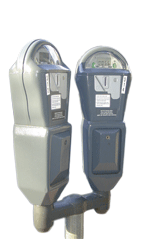Parking on campus: Cards and technology replacing concrete as the solution
It is not uncommon for a college campus to have less than one parking space for every ten students. Add faculty and staff, visitors, and vendors to that equation and it is easy to see why a parking is among the top complaints and concerns on campus today. Multimillion dollar parking garages, land grabs, and restrictive policies are common fixes though it can be argued that such attempts are band-aids rather than solutions. Can a solution be found in technology? And does the campus card play a role? Some think the answer to both of these questions is yes.
The better utilization of existing fixed resources is a theme of many new technologies. It certainly has been a mantra for campus card programs. We use the ID card to manage computer and printing resources in our libraries both to recover costs and maximize the number of students that can use the fixed resources by reducing waste and restricting unauthorized use/overuse. We use the ID card to enable time-based discounts in laundry facilities to encourage cost conscious students to utilize the fixed resources at off-peak times. And similarly, we can use the ID card and other card-enabled technologies to better utilize the fixed resource of parking locations.
The tenets of parking: access control and payment
In parking there are two distinct functions that must be evaluated: access control and payment. Access is whether or not a person or vehicle is authorized to use a parking location. This can be based on status (e.g. fee paying student, faculty/staff, visitor). Or it can be ‘pay to play’ requiring a fee to be paid for a parking permit that then entitles the individual or vehicle to access the location. While this latter example does require a payment, it is considered an access function for the purpose of parking systems as access is granted following the initial permit purchase. In an access controlled parking environment, technology may be used to ensure that only authorized individuals or vehicles are permitted to enter the parking location and enforcement-in the form of citations/tickets-can be written for unauthorized vehicles.
Payment is different from access in that the transaction of money entitles the vehicle to utilize the space for a set period of time. Payment-based solutions can rely on human attendants to accept the payments or they can utilize technology for this function. Parking meters, drop boxes, lot controlling kiosks, and card-based systems are examples of technology solutions for payment-based parking environments.
In some locations, access control and payment are combined to further control the parking environment. As an example, a location might require that a person be a fee-paying student for entry but still require a payment for use of a space for a specific time period. These solutions are ideal fits for card-based solutions in which both conditioned can be met with the same ID card-even using the same device.
Card technologies at work
In the past, a separate card or transponder was issued for parking gate control. This thick card or plastic box-like transponder could be inserted into the gate controller or held near a reader to authorize access. This card would be given to the individual when he or she paid for the parking permit or it might be given to faculty and staff automatically. In the quest to minimize the number of issuance locations and reduce the number of ID cards that students and staff needed to exist on campus, it seemed logical to combine the parking card with the official ID card. But in the early days, most parking systems utilized a separate technology that would not fit in the standard CR80-sized cards (for those still wondering why this publication is called CR80News, it is that standard credit card size termed CR80 from which we took the name). If the card was made thicker it would not work in other devices like magnetic stripe readers, ATMs, etc.
Thus solutions to control parking needed to incorporate another technology-one that fit into the CR80 form factor and preferably one that was already on the existing ID card. Today, many solutions rely on data from a magnetic stripe, a proximity card, or a contactless chip to determine access and/or initiate a payment.
Campus card vendors address the parking challenge
Many campuses have looked to their card system vendor for parking solutions. By equipping gates and entry points with card readers networked to the card system database, access can be granted or denied based on any number of eligibility indicators (e.g. status, current enrollment, parking permit payment). This can even be controlled at the micro level restricting access based on the specific location (e.g. only business majors allowed to park in the business school lot) or the time of day.
Card system vendor General Meters offers a parking module that integrates into the overall campus solution. “It supports pass/fail as well as declining balance,” says Jeff Zander, VP General Meters, “and car pool groups, anti pass back functionality, and much more.”
Diebold considers parking control to be an important element of its CSGold(TM) campus card solution. ” Features like anti-pass back, remote notification, weatherized readers, group codes, and time schedules allow for efficient lot control,” says Mark Reinart, Manager Marketing Systems and Development for Diebold. According to Mr. Reinart, a significant number of Diebold clients utilize the CSGold(TM) parking functionality for access to parking locations and more are beginning to incorporate payment functionality using the systems stored value features.
“Wireless technology is radically changing the dynamics of campus parking,” says Bret Tobey, Senior Product Manager for Diebold. Advances in wireless products enable parking control without wires, both quickly and cost effectively. Says Mr. Tobey, “(wireless technology) saves retrenching the parking lot in the process of running conduit and pulling wires.” An antenna and receiver eliminates the wiring cutting the costs significantly.
Extending security systems to parking facilities
Other solutions are available that standalone or can be incorporated as add-on technology to a campus card system or security system. Using a weatherized reader connected to a campus security system, access can be granted or denied in the same way that the system determines building door access. A variety of products are available that enable communication from a parking control device such as a gate to the security or access system using the industry standard Weigand data format used in the vast majority of security systems. A representative from your security company should be able to help identify appropriate options.
This type of solution can work with magnetic stripe cards, proximity cards, or contactless cards. Both corporations and campuses have utilized their existing proximity cards from industry leader HID for parking control. Holding the card near the reader at the entrance to a lot or garage, the ID number is read and transmitted to the security system in the required Weigand format.
A new solution enables the HID card’s data to be transmitted at distances exceeding 30 feet. This is accomplished by placing the card into a small reader that functions as a signal booster for the proximity card. HID spokesperson, Angelina Lopez, calls the solution “a long-distance Automatic Vehicle Identification (AVI) system that allows for instant identification of both vehicle and driver.” Manufactured by NEDAP, the signal booster contains its own unique ID number thus making it possible to authorize both the vehicle (via the NEDAP reader ID number) and the driver (via the prox ID number). This added security may not be necessary in all areas but it could serve a need in high security environments such as research labs or medical facilities.
Dedicated parking solutions make the grade
A wide variety of parking devices and solutions are available that operate on their own or in conjunction with a campus ID card system. Pay-on-foot solutions (also known as central pay stations, lot controllers, electronic drop boxes, etc.) allow a single payment kiosk to serve an entire lot or garage. Companies such as Federal APD, Scheidt & Bachman, SchlumbergerSema, Ascom, Traf-Park, and many more offer such devices.
Literally hundreds of parking technology providers can be found on the web our located via associations such as the National Parking Association or the International Parking Institute.
The future of parking technology
Parking technology is no longer confined to meters and gates. Solutions are available that utilize sophisticated technologies to address the parking shortage. Companies offer solutions that equip ticket writers with wireless handheld devices for real-time network access, web-based lot monitoring and control, and more. Parking payments are being made using mobile phones in locations in Europe. Radio frequency, infrared, and Bluetooth technologies are providing real-time mapping of available spaces, and individuals are accessing this data via electronic displays and even web-based handhelds and mobile phones.
Security is also coming into greater focus in parking facilities. According to Mr.Tobey, “with the advent of digital video recorders we have the ability to automatically monitor parking facilities for cars that have not moved in a given period (e.g. 2 days). This can be a great security opportunity to find stolen or abandoned vehicles.” And as a revenue opportunity, he adds, “the system also has the ability to monitor for vehicles that are illegally parked and send a message to the appropriate party.”
The future of parking is changing. Card-based systems and new technologies are providing creative people with alternative solutions. No longer is expensive construction the only answer to a parking shortage. And on most campuses, land is at a premium and certainly there is a “higher use” for available land than concrete automobile storage. Thanks to technology more and more campuses are able to maintain available land for classrooms, administrative building, or the much-needed green spaces that both students and staff deserve.



